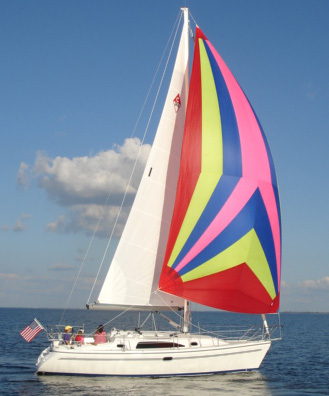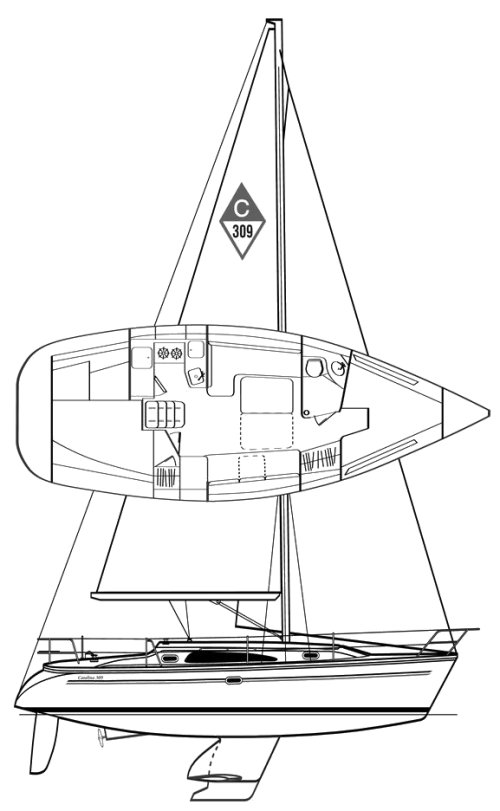CATALINA SAILBOATS FOR SALE AVAILABLE NOW ON THE GULF COAST
Catalina History + Murray Yacht Sales:
Catalina Yachts was founded in 1969 by Frank Butler in California. Catalina remains one of the largest boat manufacturers in the world, with over 80,000 boats manufactured to date. Murray Yacht Sales was a Catalina Dealer for the Gulf Coast in the 1980s so our Team knows the Catalina brand intimately. We are in regular communication with Gerry Douglas and Sharon Day. Contact us when you are looking for a Catalina or looking to sell your Catalina.
The Catalina 309 is a fiberglass monohull keelboat designed from the Catalina 310.
She was named a Boat of the Year winner by Cruising World Magazine for 2007, including “top overall domestic boat of the year award”
Catalina 309 Specs:
| Boat weight | 9,800 lb (4,445 kg) |
|---|---|
| Draft | 6.25 ft (1.91 m) |
| Hull | |
| Type | Monohull |
| Construction | Fiberglass |
| LOA | 32.75 ft (9.98 m) |
| LWL | 26.50 ft (8.08 m) |
| Beam | 11.50 ft (3.51 m) |
| Engine type | Yanmar 3YM20 diesel engine 21 hp (16 kW) |
| Hull appendages | |
| Keel/board type | fin keel |
| Ballast | 4,000 lb (1,814 kg) |
| Rudder(s) | internally-mounted spade-type rudder |
| Rig | |
| General | Fractional rigged sloop |
| I foretriangle height | 42.75 ft (13.03 m) |
| J foretriangle base | 12.00 ft (3.66 m) |
| P mainsail luff | 38.75 ft (11.81 m) |
| E mainsail foot | 13.75 ft (4.19 m) |
| Sails | |
| Mainsail area | 266.41 sq ft (24.750 m2) |
| Jib/genoa area | 256.50 sq ft (23.830 m2) |
| Total sail area | 522.91 sq ft (48.580 m2) |
Catalina 309 Images:
—————————————————————–
Catalina 309 Reviews:
Cruising World Review
Catalina 309: A Collaborative Compact Cruiser
HOW THE HECK DO YOU REPLACE AN ICON? INNOVATE.
BY Jeremy McGeary POSTED August 9, 2006
Link HERE
————————————————————————————-
Catalina 309 Video Review
————————————————————————————–
SAIL Magazine Reviews the Catalina 309
2006-12-04
Catalina’s designer, Gerry Douglas, knew he was taking a risk when he took on the job of improving a bonafide success. The Catalina 30 has had a production run most boatbuilders only dream about (nearly 7,000 have been built, and it’s in the Sailboat Hall of Fame), but Douglas couldn’t resist the challenge.
The Catalina 309 represents his attempt to walk a fine line between retaining all the features that made the 30 so popular – easy handling, good sailing performance, and simple, comfortable accommodations-while redesigning the hull, deck, and systems to provide increased interior volume, better sailing performance, and the modern systems (refrigeration and optional A/C) we’ve come to expect on anything bigger than a dinghy. I took a 309 for a test sail on Biscayne Bay, off Miami, Florida, to see if a boat with Hall of Fame credentials can be improved.
UNDER WAY
I was impressed with the 309 before we even got out of the marina. Catalina’s rep backed the boat out of the slip, gave me the wheel, and said, “Want to see something cool? Turn the wheel hard over and see what happens.” The boat spun around in the tightest turning circle I’ve ever seen a monohull make under power. Conclusion: The hull form is highly maneuverable under power, a feature new sailors and old hands will appreciate.
With those tight turning circles and the bemused looks from the dock committee still fresh in my mind, we motored out into a 12-knot breeze. I had a feeling the 309 would excel under sail, and I was right. Railing the main and unrolling the jib was relatively effortless. The boat cut a clean wake and slipped through the light chop. Upwind, the boat was extremely well-mannered, and we were able to kiss 6 knots in the puffs. Overall speeds were consistently in the 5-knot range, and we tacked through 85 degrees. Tacking was crisp, and acceleration out of the tacks was good. Speeds were similar off the wind. The boat was simply well-behaved.
Under full sail the heel angle was comfortable and not excessive. Getting a good look at the sails from the helm required experimenting with sight lines, because the optional bimini (like most biminis) was designed for maximum sun protection rather than for telltale visibility. I single-handed the boat through tacks and gybes; the helm was balanced enough to leave untended for minutes at a time.
ON DECK
The changes on the new 309 are both subtle and profound. The addition of little more than a foot to the boat’s LWL and LOA has increased its speed potential. Adding 8 inches of beam increased interior volume, but did not make the stern appear overly chubby. Redesigning the deck ports and hatches has updated the overall look of the topsides and also allows for more light and ventilation below. What wasn’t changed was the overall comfort and efficiency of the deck and cockpit layouts. As with most Catalina designs, you can stretch out for a nap on the 6-foot-long cockpit seats; the angle of the cabinside forward provides a perfect backrest if you prefer to sit. All lines lead back to the cockpit, and winches on the coachroof are close enough to the helm to make for easy sail adjustments. Wide side decks and shrouds located well inboard make it easy to reach the foredeck, and the molded-in-diamond-pattern antiskid is effective without being abrasive. Other beneficial features on deck include a walk-through transom with swim platform, well-placed stainless-steel grabrails, sturdy stanchions, and decent cockpit-locker space.
ACCOMMODATIONS
Increased beam wasn’t the only way this boat’s accommodations were enhanced. The well-designed U-shaped galley provides enough counter and stowage space-along with a two-burner stove and refrigeration that automatically switches from AC to DS power – to meet the demands of a week-long cruise.
Like the cockpit seats, the saloon seats are long enough to stretch out on and make excellent seaberths. The table seats six for dinner, it can be dropped down to form another berth or folded up out of the way against the main bulkhead. One new feature is a small retractable table situated on the starboard side of the saloon. The aft-facing nav station is functional for a 30-foot coastal cruiser. It has a small nav deck, and to sit at it the navigator must perch on the end of the starboard settee. Catalina was one of the first builders to fit a large double berth into a small coastal cruiser. The 309s aft cabin has room for two to sleep, but not much else. Up forward, there is a V-berth double, with excellent ventilation through a large forward-facing deck hatch, good headroom, and copious storage lockers (including a hanging locker). And unlike older 30-foot Catalinas, the 309 comes from the factory with air-conditioning ductwork already installed. Living in luxury required only a check on the option list.
CONCLUSION
The trouble with redesigning a successful boat is that the builder must compete with its past success on the used-boat market. Thousands of Catalina 30s are still sailing, and there is no shortage of them on the brokerage market. However, the new 309 is an excellent coastal cruiser that represents a significant upgrade over its predecessor.
——————————————————————–
The Catalina 309: A Review
JULY 31, 2009 BY TOM
Sailing the Catalina 309: A Review
————————————————————————————-
Catalina 309 Review – Cruising Helmsman (October 2007)
“HARD ACT TO FOLLOW”
Words by Caroline Strainig
———————————————————————————————-
Sailboat Data – Specifications
———————————————————————————————-
Click the logo below to view our Catalina Sailboats For Sale

Click to view our current list of sailboats for sale
Catalina 309 reviews speifications and more






1 Comment